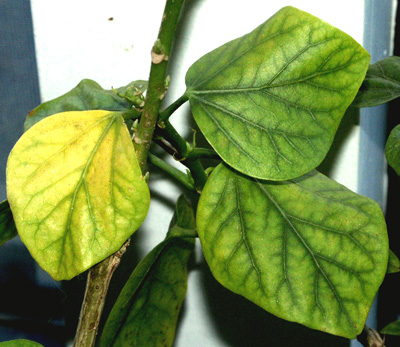Hibiscus Plant Care
Chlorosis
Yellow Leaves ~ Is it Chlorosis?
 'Chlorotic Hibiscus Leaves' |
The green we see in the leaves and stems of plants is a green pigment called "chlorophyll." Chlorophyll is much more than a pretty color. It is the essential substance that a plant uses to produce food and energy from sunlight, fertilizing nutrients, and water. When all of a plant's leaves begin to lose their green color, this means they are losing their chlorophyll, or the ability to produce food and energy for growth and flowering. "Chlorosis" is a special situation where plants have some kind of condition, such as a disease or nutritional deficiency, that causes them to produce less chlorophyll than normal.
How Can I Tell Chlorosis from other Causes of Yellow Leaves?
For our purposes, chlorotic leaves on hibiscus are those that turn yellow but do not fall off right away. Most other causes of yellow leaves result in the leaf falling off shortly after it turns yellow (spider mites, normal replacement of aging leaves with new leaves, extreme weather conditions, etc). When hibiscus leaves become chlorotic, they usually turn yellow between the veins that are visible on the leaf, while the veins themselves remain green. This gives a more mottled impression than a leaf which quickly turns yellow all over and then falls off. Chlorotic leaves will eventually turn brown along their edges, then the whole leaf may yellow and fall off, but this is a very slow process.
What Causes Leaf Chlorosis?
There are many possible causes of chlorosis. These are the causes we most commonly see:
- Iron deficiency in the soil or potting mix
- Magnesium deficiency in the soil or potting mix
- High pH (above 7.2) of the soil or potting mix - or an "alkaline" soil
- Overly wet and poorly drained soil that damages the roots' ability to absorb minerals
- Fungus or other pathogens that damage the roots' ability to absorb minerals or the plant's ability to use them
What Do I Do about Chlorosis?
First, determine the cause of your plant's chlorosis.
- If your plant's soil is overly wet or poorly drained, start by correcting this and see if that solves the problem.
- If the chlorotic leaves are at the ends of the stems, in the newest and youngest growth, then the problem is usually an iron deficiency.
- If the chlorosis shows up in the lower leaves, the older growth, it is most likely a magnesium deficiency.
 Chlorosis at the tips of branches in the youngest leaves is usually caused by a deficiency of iron |
- If the problem appears to be overly wet or poorly drained soil, then stop and correct this before trying anything else.
- If soil is not overly wet and it drains well, then try correcting for mineral deficiency.
How Do I Correct for Mineral Deficiencies?
Treatment involves making more iron or magnesium available to the plant. Both are used by the hibiscus to make chlorophyll, which is what makes the leaves green.
- A quick but temporary fix can be achieved by spraying the leaves of the chlorotic plant with either iron chelate or magnesium sulfate, depending on which mineral appears to be deficient.
- A longer lasting fix is achieved by applying iron chelate or magnesium sulfate to the soil or potting mix that the hibiscus is growing in.
 Iron Chelate made with FeEDDHA |
What If These Treatments Don't Work?
 Magnesium Sulfate |
2. If the pH of your Soil or Potting Mix is above 7.2, Treat to Lower the pH : The classic way to lower pH of soil or potting mix is to mix elemental sulfur and iron sulfate (ferrous sulfate) into it. This provides a long lasting fix for the problem and should eliminate iron-based chlorosis for 2 years or longer. The recommendation is to mix the two minerals together, half and half, then introduce them into the soil before watering them in. This lowers the pH and adds iron to the soil. Results are slower to see, but longer lasting and a more complete fix for the problem.
Lab Work - Is It Useful?
An agricultural lab will do a complete soil analysis for you that will reveal the amount of all the important nutrients contained in your soil, as well as the pH. A soil analysis usually costs less than $100 and can be helpful if you are not confident about the quality of the soil you are planting in. Another useful test that you can have done at the same time is a water analysis for agricultural purposes. This will tell you the water pH and the amount of minerals in your water. The most complete picture of the growing situation can be obtained by sending some leaf samples to the lab where they will be analyzed to see if all the needed minerals are present in the leaf. This is how large commercial operations keep their plants growing on schedule, and obtaining this information can also be useful to the home gardener.
OK, so this sounds like a lot of trouble and expense to go to! We agree! We only recommend lab analyisis of soil, water, or plant leaves for those with stubborn chlorosis problems, or for those with enough money, time, and interest to make the experience of working with an agriculture lab enjoyable.
| Back to YELLOW LEAVES |